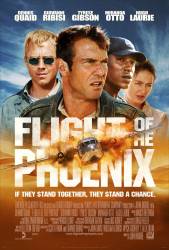Question: What are cowl flaps? What is their purpose?
Question: How realistic is Elliot's plan of building a new plane?
Answer: A flying version of the design about 1/2 scale was built and flown for the original 1965 film. It appears in several flying scenes in that movie, but tragically crashed during filming, killing stunt pilot Paul Mantz.
Answer: Completely realistic. As explained correctly in the film, the aerodynamic principles involved are valid. Given that the constructed aircraft would have oversized wing surface area and an excess of power available, it should fly. Disruption of the airflow over the top of the wing due to the passengers would be minimal. In the 1930's airshows featured multiple wing walkers atop much smaller and lower powered aircraft.
Answer: Stupidly unrealistic. The plane simply wouldn't fly with people hanging off its wings for a start.
There's a big difference between a single wing walker on a high lift biplane compared to 10 people hanging off the wings.
Search on "multiple wing walkers" and see a 160 hp biplane carrying 5 walkers. So, for the C-119 there is about 2894 square feet of wing area, call it 2000 after cut down. The PW R-4360 produces 3500 hp, but let's use only 30% of that to protect the cobbled airframe. 10 guys on the wings are going to disrupt airflow over about 12 square feet each leaving about 1880 square feet of unobstructed wing being driven by 1000 hp. 30 people on the wings would not stop it from flying.
Question: When nomads shoot the person and he is dying, he says something in the ears of Mr. Towns and Mr. Towns reacts with bad expressions. This is never revealed later in the movie. What possibly could he have said in the ears of Mr. Towns?
Answer: Later on in the movie before they get ready to take off, Mr. Towns is asked that same question and his reply was he said "don't crash" to Mr. Towns.
Question: When Towns finds the body that fell out, how come it's not in too bad condition after falling such a long way and onto dirt? Is the dirt what kept his body in pretty good condidtion after falling out? If so, please help me on this.
Answer: The person may have fallen on to a sanddune, in which case the landing would have been softened, but not to a point to prevent death.
Question: What is the name of the song played when the plane leaves the oil rig?
Answer: "Gimme Some Lovin'" by The Spencer Davis Group.
Question: Where did the nomads get ammo for the guns and gas for their motorcycles?
Answer: They bought/robbed or traded for them with other nomadic tribes or in the cities.
Question: The largest sandstorms ever recorded are less than a mile high (reaching only about 5000 feet in altitude). Isn't 5000 feet considered low altitude for a Fairchild C-119G "Flying Boxcar," which could easily climb over such a storm in a matter of minutes?
Question: Why was the camel left with the 2 murdered men?
Answer: It is stated very plainly that the Arabs left the camel behind because it was lame. This was a dramatic device to demonstrate the Arabs' ruthlessness: They murdered two human beings in cold blood, but allowed a lame camel to live. Note that the camel scene appears in the 1965 film, but not at all in the 2004 film.
Question: In the crash scene, shouldn't all the people on the plane, including the pilots, have seriously injured if not dead?
Answer: It is possible for a plane to crash in such way that the pilot and passengers can survive unharmed. There are documented cases of survivors walking away from a crash. It just depends on the pilots skills, how the plane lands, and what type of ground the plane hits. The desert sand would cushion the impact somewhat.
Answer: "The Flight of the Phoenix" (both the original film and the remake) is a fictional tale about a group of men beating odds that are overwhelmingly against them. Just the fact that they survived the desert crash is incredible enough, and that is what sets the tone for a whole series of death-defying events thereafter. It's sensational movie-making, stacking one death-defying event atop another; after all, there would be little reason to watch an adventure film in which everyone dies in the first 15 minutes. There are, of course, real-life incidents that are equally sensational: the crash landing of U.S. Airways Flight 1549 in the Hudson River in 2009, for example. All 155 passengers and the crew of Flight 1549 incredibly survived, against all odds (as depicted in the 2016 film "Sully").






Answer: Cowl flaps are used to adjust to volume of air that passes over the cooling fins of an aircraft piston engine. Under takeoff and landing these flaps are open to allow maximum airflow and under normal flight they are closed to maintain normal engine temperature.
Andreas[DK]